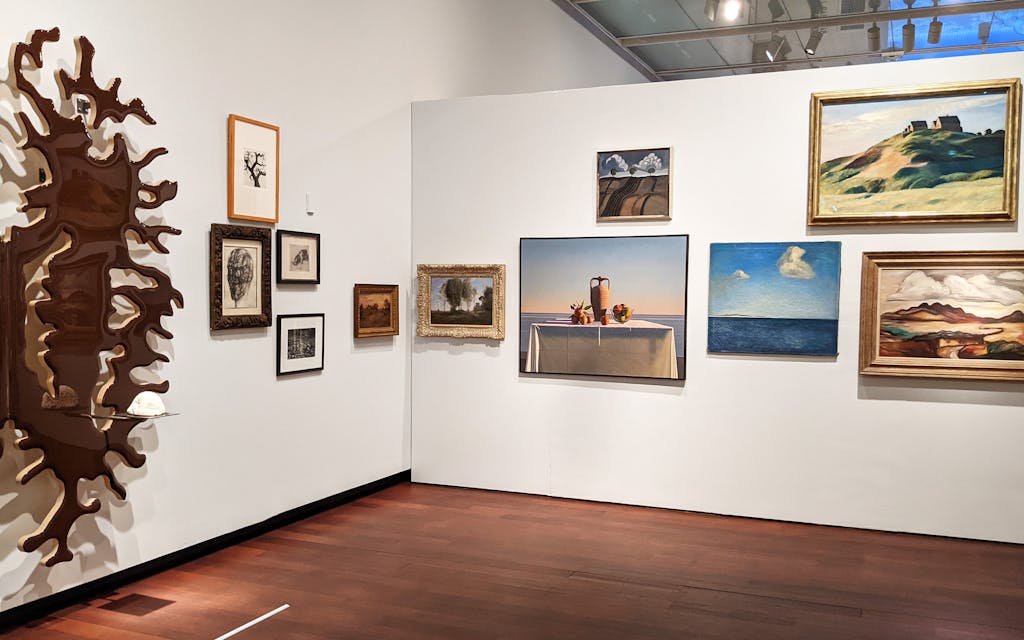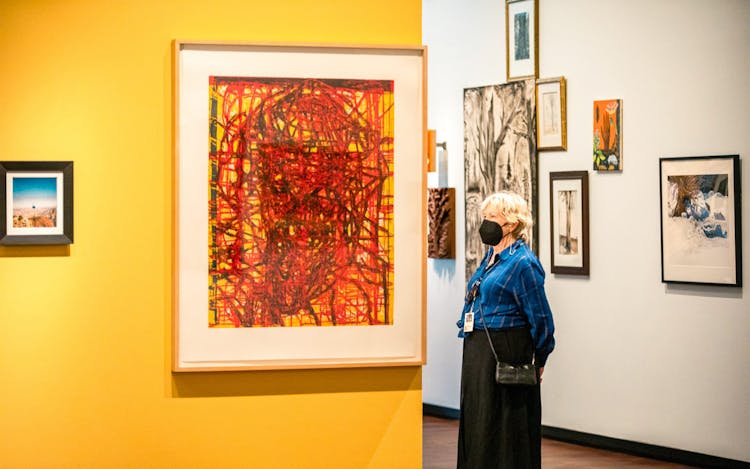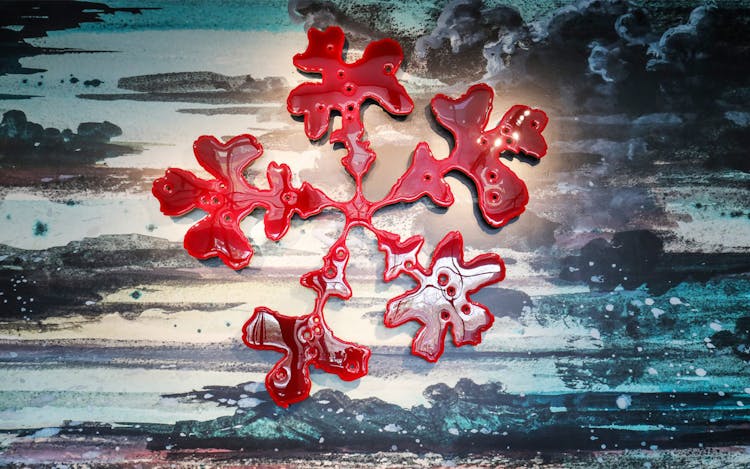“Nature Cult,” Donald Moffett’s encyclopedic and bewitching art show on view through September 11 at the McNay Art Museum in San Antonio, is a whirlwind tour of highlights from the past century and a half of nature-oriented art from Europe and the Western Hemisphere. The unusual exhibition design was conceived by Moffett and his local collaborator, McNay head of curatorial affairs René P. Barilleaux, as part mixtape curation and part novel creative expression. It includes a rehang of over 140 impressive selections from the museum’s permanent holdings, additional dozens of works from Moffett’s personal collection by other artists, and sixteen Moffett originals sprinkled throughout.
Monet’s water lilies are here (as always at the McNay), along with Edward Hopper’s sand dunes and John James Audubon’s animal portraiture, but there’s also an Ed Ruscha gas station, a Leonardo Drew trash collage, and various abstract, tongue-in-cheek, documentarian, and more or less stridently environmentalist works from artists of varying levels of prominence. It’s an unruly, teeming show, peculiarly hung and of puzzling intent as it relates to Moffett’s own work, which makes up only a small fraction of what’s on view. Still, it holds together nicely with a consistent sensibility rooted in reverence and mourning for a threatened natural world.
Moffett, who grew up in San Antonio, says he decided to become an artist after an encounter with a Georges Seurat drawing at the McNay. Score one for art making a decisive impact on the viewer, an ambition that underlies the alarmist environmentalist aspect of “Nature Cult.” That early inspiration bore fruit—after earning degrees in art and biology from Trinity University in his hometown, Moffett, now 67, built a successful art career in New York. In the late 1980s, he became known for his outraged and straightforwardly political art for the crucial AIDS activist group ACT UP. In one iconic print, He Kills Me, Moffett calls out Ronald Reagan for his culpability in the mass death of gay men who contracted HIV, then a new and poorly researched virus.

In recent decades, Moffett’s art has matured into more indirect and arguably abstract bodies of work, though he is still inspired by political themes ranging from antigay violence to the wardrobe of former U.S. congresswoman Barbara Jordan, a fellow Texan. As Moffett’s aesthetic interest has shifted into exploring the materiality of paint, canvas, wood, and other materials, the representational relationship between his art and his stated subject matter can be increasingly difficult to see. Still, his work continues to attract acclaim, including a flattering 2019 New York Times profile that featured works included in “Nature Cult.”
The strangest thing about “Nature Cult”—which is full of odd visions, like a spiky rubber sculpture by Chakaia Booker suggesting a sadomasochistic porcupine, a large-scale print of a psychedelic dreamscape studded with feathers and crystals by Jose Alvarez (D.O.P.A.), and a grotesque puppet of a dying polar bear by Iker Vicente—is the relative restraint of Moffett’s own works. Austere and indecipherable, they hang back coyly among their more famous and eye-catching peers. One might even doubt if Moffett’s works included here are meant to comment on nature at all, if not for the two brief paragraphs of exhibition text at the entrance to the show, which introduce “Moffett’s monochromatic paintings based on the natural environment and its precariousness.”
Apart from that brief introduction, there’s no wall text anywhere in “Nature Cult.” Paintings and sculptures are arranged in intentionally disorderly fashion around the space, with no identifying labels, so that we’re often not sure what or whom we’re looking at. (Perplexed viewers can consult mounted gallery maps to help sort things out after the initial immersive viewing experience.) Furthermore, which works abut others is a matter of intuition rather than chronology, geography, or authorship. “We’re really trying to explore and exploit the way works of art are presented in a museum setting,” Barilleaux says. “The labels are not at the forefront. You’re looking first.”
This is serious fun, but most visitors are likely to lose the thread of Moffett’s work amid so many other diverging visions. And without titles or interpretations, we have little hope of guessing what Moffett’s intended political statement is with any given product of his own studio. For example, if we know the title of his “Lot 052021 (the air we breathe)”—a huge wooden surface painted blue with holes cut out of it at angles—we can guess that it might be intended as a criticism of smog or greenhouse gas emissions. Without the title, viewers are very likely to be flummoxed or to take it as an abstract work.
Does that matter? Not to Moffett, it seems, and fair enough. His artworks look fabulous, striking but neutral potential additions to any collector’s home walls, regardless of whether we can make heads or tails of them or if we’re even meant to be able to do so. Amid the pictorial abundance of “Nature Cult,” Moffett’s own pieces stick out like sore thumbs, big and bright, smooth and seamless.


Left: Art by Terry Winters (left center). Multiple Visualization Technique, 1998. McNay Art Museum
Top: Art by Donald Moffett. McNay Art Museum
Could it be that Mondrian, Goya, Diane Arbus, Kiki Smith, et alia are all here just as window dressing, as an elaborate frame for presenting Moffett’s work? If so, it’s a bold move, bordering on egomaniacal. But I don’t think that’s right. By allowing other artists to outnumber him by nearly ten to one, Moffett makes “Nature Cult” primarily about something beyond himself. This largesse is the aspect of the show that will be most appealing to broad audiences. Throughout the hot summer months of 2022, it will deservedly draw in visitors from San Antonio and beyond to wander in the cool thicket of this bountiful exhibition.
A key question that remains with us after leaving the exhibition is what Moffett means by the title, in particular the word “cult.” His intention is not explained in the exhibition text, so we’re free to supply our own guesses at Moffett’s quasi-religious aims. My thoughts go to French theorist Georges Bataille, who wrote in his Theory of Religion that “the animal is in the world like water in water,” positing that religion and certain kinds of art and poetry are an attempt to get back to that immediacy of experience of nature and life itself. “Nature Cult” seems curated to cultivate this effect. These rooms are chock-full of fantastic art, and the disorienting curation encourages us to lose ourselves and swim in it. The question of Moffett’s mysterious works and what he’s after falls away, or perhaps floats above it all. Meanwhile, the waves of each artist’s vision hit us one after another, until we feel ourselves unmoored, our own visions and thoughts about mankind’s tenuous place in the natural world mixing and combining with others’, across generations in a conversation without end.

